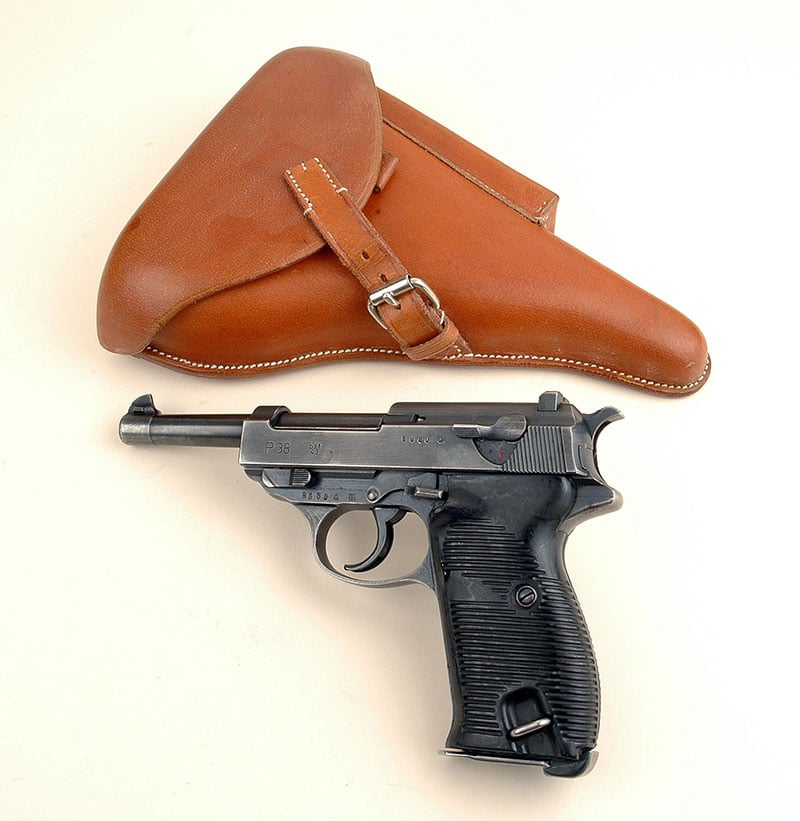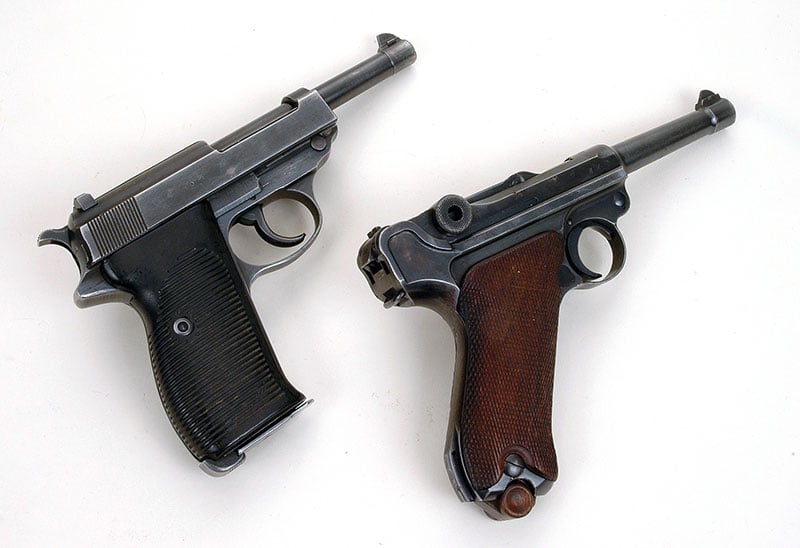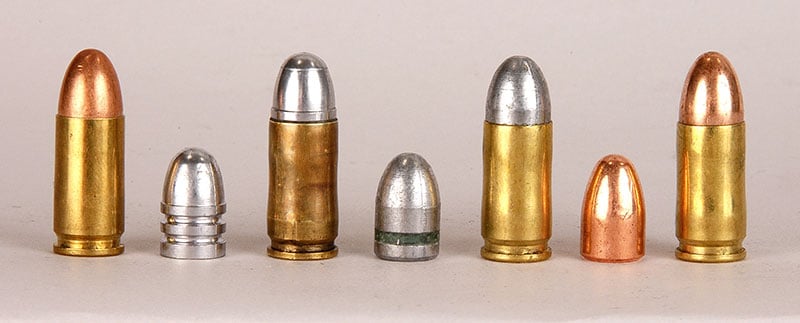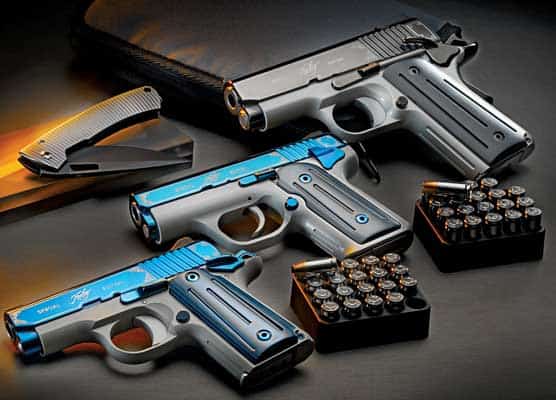Handguns Of WWII, Part 5
The German P38 9mm
Part 5 Of A 13-Part Series
Next to the Luger, Germany’s most recognized World War II handgun was the Walther-designed P38. It’s credited as being the first military pistol with a double action trigger pull. As with the Luger, it was issued to the German army (Heer) in 9mm Parabellum. However some commercial P38s were chambered for the 7.65mm Parabellum round.
Actually the name P38 is slightly misleading. The Germans didn’t adopt this design in 1938 as the name implies, but rather it was approved for issue April 26, 1940. (Source: “GUNS OF THE THIRD REICH” by John Walter). What is very interesting is the reason for the delay from 1938 to 1940. Walther’s initial design for the P38 incorporated an internal or concealed hammer. German ordnance officers did not like that feature and requested Walther to redesign it with an exposed hammer. What I find odd about that fact is the Luger (P08) which had been their standard sidearm since 1908, had an internal striker.
Something else that should be said is the German Wehrmacht, which included the army (Heer), navy (Kreigsmarine) and air force (Luffwaffe), collectively were not unhappy with their Lugers. In fact all three services kept them in use right until the Third Reich’s surrender in 1945. The reason for the P38’s existence was because Lugers were very intricate, time-consuming pistols to manufacture. The Germans wanted one easier to make — and cheaper too.
Best One?
The pistol they got was arguably the finest handgun used by any nation in World War II. Naturally at this point rabid Colt 1911 fans are gnashing their teeth and thinking, “How could any 9mm be better than the American .45 ACP?” It’s doubtful if anyone shot with the lowly 9mm bullet from a P38 ever shrugged it off. The trade-off in knockdown power was countered by these factors. A German soldier could carry two 9mm cartridges for the weight of one .45 ACP round, along with a pistol weighing about a half pound less. Also its magazine held eight cartridges to the 1911’s seven. Finally it was safer to carry with a round chambered due to its double action trigger mechanism.
The Walther firm couldn’t begin to produce enough P38s to cover Germany’s needs, so in 1942 the firms of Mauser and Spreewerkes also began manufacture. Over the decades since World War II collectors have divided P38s into a myriad of different versions, sometimes sorted simply by the markings stamped on them.
Regardless, all P38s are of a type. They have 5″ barrels, were given a dull blue finish, have a large, square rear sight with notch dovetailed into the slide and a ramp type front sight dovetailed to a stud near the muzzle. They have a “hammer drop” safety: meaning if the hammer is at full cock then when the safety is engaged it drops. There is no danger of firing, because as the safety lever is rotated a block of steel bars the hammer from hitting the firing pin. Also when the safety is engaged the double action trigger is disengaged. When the safety is disengaged then the double action trigger is re-engaged. That’s German engineering at its best.
Another fine idea for a combat handgun is the loaded chamber indicator at the rear of the slide just above the hammer recess. Therefore a German Landser (infantryman) sitting in a foxhole in the dark can tell if his handgun is ready to use without making noise. It’s also probably safe to say all German military P38s are marked with manufacturer’s code and year it was made. For instance, my P38 is marked “byf 43” meaning it was made by Mauser in 1943. I have not included all the different manufacturer codes because the subject is just too complex to cover here.
In my casual research I have not stumbled onto exact production figures for each P38 manufacturer in World War II. John Walter, in his above mentioned book, gives 590,000 as the total made before war’s end. He does say Spreewerke was the largest producer with 275,000 to their credit. Here’s an utterly fascinating tidbit from his book. According to Walter in one month alone — July 1944 — the Germans lost 52,090 pistols of all types.
Shooting
From the shooter’s standpoint P38s are joys. I’ve found them to be much more reliable than Lugers. Whereas the latter pistol has a well-deserved reputation for finicky-ness with ammunition, the P38 seems to digest just about any decent load put into it. I’ve fired mine with several types and shapes of jacketed bullets, commercially cast roundnose bullets, and my own home cast roundnose bullets. All have functioned fine, which is not the same as saying my P38 has always been 100 percent reliable.
It will fail to totally eject a case perhaps once in every couple hundred rounds. A factor by which I think Lugers, in general, surpass P38s, in general, is in inherent accuracy. Again I’m judging that by a single specimen of each in my collection. However, it’s something several books dedicated to World War II firearms also mention.
Another engineering point where the German P38 designers should get an extra “attaboy” is with the sights — or rather the ability of the P38’s sights to be zeroed. Again let’s compare the P38 to the U.S. Model 1911. That latter handgun can only be zeroed for windage. The front sight is staked into the slide so elevation is what you get. On the other hand there are various heights of sight blades available for P38’s so elevation can be adjusted. Furthermore, those blades can be drifted laterally in their dovetails in order to change windage too. My P38 hit center but very low when I bought it. A visit to my gunsmith revealed he had a handful of P38 sight blades in stock. We picked the lowest and put it in. Bingo! Now my P38 hits to its sights with most loads.
Perhaps the best compliment given to the P38 is one I read in one or another of my many books on World War II firearms. It said American GIs wanted Lugers for souvenirs — but they picked up P38s to use for fighting.
Click here to links to all the 13-part on-line series of Handguns Of World War 2 articles.









